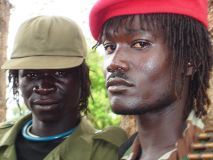Sudan’s Ri-Kwangba: A meeting point for the Ugandan rebels
June1, 2007 (RI-KWANGBA) — Facilities have been established in Ri-Kwangba during the talks to effectively institutionalise the LRA in this remote location near the Sudan-Democratic Republic of Congo border – a significant political and social shift for the secretive group.
 The meeting area – only a few hundred metres from the LRA bush headquarters in the DRC – has a water point, portable toilets, storage huts and a clearing for a large tent. When needed, international delegates are flown in and out by helicopter, and hundreds of plastic chairs, a generator, and a lunch of rice and stew brought in by road. Communication facilities and food have also been provided.
The meeting area – only a few hundred metres from the LRA bush headquarters in the DRC – has a water point, portable toilets, storage huts and a clearing for a large tent. When needed, international delegates are flown in and out by helicopter, and hundreds of plastic chairs, a generator, and a lunch of rice and stew brought in by road. Communication facilities and food have also been provided.
This is the only place where decisions can be made directly with the leaders. Kony and Otti are too concerned for their personal security to come to Juba, capital of Southern Sudan, where the official peace talks are taking place. But representation in Juba by LRA delegates is hampered by the movement’s highly centralised structure and decision-making process.
Structure and tactics
The LRA is made up of small brigades – independent clusters of 10 to 20 soldiers. They work with speed and aggression and have been effective in spreading widespread terror with very few combatants. According to the Ugandan government, there are only 500-1,000 soldiers in total, many of the original LRA combatants having been killed in conflict or died of ill health, including HIV/AIDS.
However, these figures are disputed. Military sources and international observers in Southern Sudan estimate that there could be as many as 3,000 LRA fighters, with about 1,500 women and children in tow.
Highly centralised and disciplined, the LRA has shown itself responsive to ceasefire orders, but the brigade structure means orders can take time to reach the units. The Ugandan and Sudanese governments are aware of ‘copycat’ groups that ambush and kill in areas affected by the LRA, which sometimes get blamed on LRA.
The LRA is notorious for mutilations and abductions. Sources close to the group say there have been four or five specific orders during the course of the conflict to deliberately inflict brutality, including mutilations and rape, in retaliation for government military operations that involved the cooperation of civilians.
The LRA has benefited from tacit, underground support from communities in northern Uganda, despite its brutality. Collaborators are used to provide information, batteries, rubber boots and other basic supplies. LRA raids target communication tools, medical supplies and food. Copycat groups are usually older men who go for high-value goods and cash.
Over the past few years, the trend has been a decline in attacks and sightings of the LRA, which were much stronger on the ground in the 1990s. Abductions and killings have been a feature of the movement, and have persisted in Sudan, with reports of about 15 Sudanese children known to have been abducted by the LRA over the past year. Abducted children are usually tied together and used as porters; their fate is unpredictable. Some are shot or killed, some are released, others are kept by the movement. Former abductees report being forced into murderous initiation rites. Forced to kill their relatives and friends, children feel they are unable to return to their families and community. Extreme fear is used to keep the children with the movement, while they undergo military training.
According to military sources in the region, the young recruits were trained in Sudan during the time the LRA received support from the government in Khartoum. The children are brought back into bush, used as porters, and subjected to an initiation rite where they are forced to kill someone – often children who try to flee. “It is a way of bringing the child into a position of absolute obeisance,” explained one source close to the LRA. Then they are sent to training facilities for about two months, and taught how to shoot, operate in the bush, raid and ambush, use hand and whistle signals, and take orders. After training they are deployed to different units.
LRA soldiers carry a variety of weapons, mostly Kalashnikovs, typically with bayonets. Many of the young soldiers have short beaded dreadlocks, and trademark rubber boots. Those in uniform are well presented, with insignia patterns based on Ugandan and Sudan government designs.
Since April, the LRA has agreed to assemble their troops in Ri-Kwangba, which entails moving their units from northern Uganda, and from east of the Nile in Southern Sudan, to the Sudan-DRC border. Earlier attempts to assemble at designated points failed, partly – say military observers – because the Ugandan military had blocked key areas of transit. The new agreement in April depended on support and assistance from the Sudan People’s Liberation Movement/Army (SPLM/A), which now leads mediation attempts in Southern Sudan.
(IRIN)
